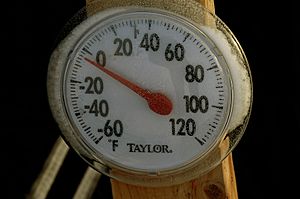Negative temperature facts for kids

In physics, absolute zero is the coldest possible temperature. It's like the ultimate "cold limit." At this point, tiny particles inside objects almost completely stop moving. This is also called 0 Kelvin (0 K). But did you know that some very special things can actually get even "colder" than absolute zero? This strange state is called a negative temperature. It's super hard to do, and scientists can only make very small objects reach these temperatures.
It might sound confusing, but objects with a negative temperature are actually hotter than anything at a positive temperature (above absolute zero). Imagine you have something with a negative temperature and something with a positive temperature. If they touch, heat will always move from the negative-temperature object to the positive-temperature object. This happens because temperature is about how energy and entropy (a measure of disorder) balance out.
Contents
What is Absolute Zero?
Absolute zero is the lowest temperature that is theoretically possible. It's the point where particles have the least amount of energy. Think of it like a car running out of gas and stopping completely. At absolute zero, atoms and molecules have almost no motion. This temperature is 0 K, which is about -273.15 degrees Celsius or -459.67 degrees Fahrenheit.
How Can Temperatures Be Negative?
Normally, when you add energy to something, its temperature goes up, and its particles move more. This also increases its entropy. But for very special systems, mostly tiny ones studied in quantum mechanics, adding energy can actually make their entropy decrease. When this happens, their temperature can become "negative" on the Kelvin scale.
Why Negative is Hotter
This idea of negative temperature is tricky because it doesn't work like our everyday understanding of hot and cold. Imagine a ladder where positive temperatures go up, and absolute zero is the bottom. Negative temperatures aren't below the bottom; they're like a special "top rung" that's even higher than the highest positive temperatures. If you add energy to a normal object, it gets hotter. If you add energy to a negative-temperature object, it also gets "hotter" in a way that makes it want to give energy to anything else.
How Scientists Create Negative Temperatures
Scientists can create negative temperatures using special methods, often involving laser science and magnetism. They usually work with very tiny groups of atoms, like those found in a gas. They carefully control the energy levels of these atoms. It's like pushing all the atoms into a high-energy state, which is the opposite of what happens at absolute zero.
What Can Reach Negative Temperatures?
Most everyday objects cannot reach negative temperatures. This is because their particles are always trying to spread out and become more disordered (increase entropy). Only very specific systems, often involving plasma physics or special quantum systems, can be manipulated to achieve this unusual state.
Uses of Negative Temperatures
While negative temperatures are mostly a topic for advanced physics research, they could have interesting uses in the future. Scientists are studying them to understand more about energy, heat, and the strange rules of quantum mechanics. They might help us develop new technologies or understand how certain materials behave in extreme conditions.
Images for kids
See also
 In Spanish: Temperatura negativa para niños
In Spanish: Temperatura negativa para niños


